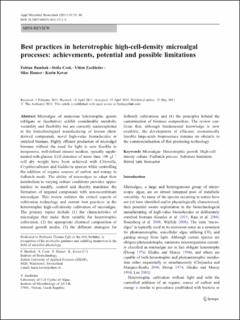Please use this identifier to cite or link to this item:
https://doi.org/10.21256/zhaw-4872Full metadata record
| DC Field | Value | Language |
|---|---|---|
| dc.contributor.author | Bumbak, Fabian | - |
| dc.contributor.author | Cook, Stella | - |
| dc.contributor.author | Zachleder, Vilém | - |
| dc.contributor.author | Hauser, Silas | - |
| dc.contributor.author | Kovar, Karin | - |
| dc.date.accessioned | 2018-11-16T10:10:16Z | - |
| dc.date.available | 2018-11-16T10:10:16Z | - |
| dc.date.issued | 2011 | - |
| dc.identifier.issn | 0175-7598 | de_CH |
| dc.identifier.issn | 1432-0614 | de_CH |
| dc.identifier.uri | https://digitalcollection.zhaw.ch/handle/11475/12906 | - |
| dc.description.abstract | Microalgae of numerous heterotrophic genera (obligate or facultative) exhibit considerable metabolic versatility and flexibility but are currently underexploited in the biotechnological manufacturing of known plant-derived compounds, novel high-value biomolecules or enriched biomass. Highly efficient production of microalgal biomass without the need for light is now feasible in inexpensive, well-defined mineral medium, typically supplemented with glucose. Cell densities of more than 100 g l(-1) cell dry weight have been achieved with Chlorella, Crypthecodinium and Galdieria species while controlling the addition of organic sources of carbon and energy in fedbatch mode. The ability of microalgae to adapt their metabolism to varying culture conditions provides opportunities to modify, control and thereby maximise the formation of targeted compounds with non-recombinant microalgae. This review outlines the critical aspects of cultivation technology and current best practices in the heterotrophic high-cell-density cultivation of microalgae. The primary topics include (1) the characteristics of microalgae that make them suitable for heterotrophic cultivation, (2) the appropriate chemical composition of mineral growth media, (3) the different strategies for fedbatch cultivations and (4) the principles behind the customisation of biomass composition. The review confirms that, although fundamental knowledge is now available, the development of efficient, economically feasible large-scale bioprocesses remains an obstacle to the commercialisation of this promising technology. | de_CH |
| dc.language.iso | en | de_CH |
| dc.publisher | Springer | de_CH |
| dc.relation.ispartof | Applied Microbiology and Biotechnology | de_CH |
| dc.rights | https://creativecommons.org/licenses/by-nc/4.0/ | de_CH |
| dc.subject | Biomass | de_CH |
| dc.subject | Biotechnology | de_CH |
| dc.subject | Cell Culture Techniques | de_CH |
| dc.subject | Culture Media | de_CH |
| dc.subject | Microalgae | de_CH |
| dc.subject.ddc | 570: Biologie | de_CH |
| dc.title | Best practices in heterotrophic high-cell-density microalgal processes : achievements, potential and possible limitations | de_CH |
| dc.type | Beitrag in wissenschaftlicher Zeitschrift | de_CH |
| dcterms.type | Text | de_CH |
| zhaw.departement | Life Sciences und Facility Management | de_CH |
| zhaw.organisationalunit | Institut für Lebensmittel- und Getränkeinnovation (ILGI) | de_CH |
| dc.identifier.doi | 10.21256/zhaw-4872 | - |
| dc.identifier.doi | 10.1007/s00253-011-3311-6 | de_CH |
| dc.identifier.pmid | 21567179 | de_CH |
| zhaw.funding.eu | No | de_CH |
| zhaw.issue | 31 | de_CH |
| zhaw.originated.zhaw | Yes | de_CH |
| zhaw.pages.end | 46 | de_CH |
| zhaw.pages.start | 31 | de_CH |
| zhaw.publication.status | publishedVersion | de_CH |
| zhaw.volume | 91 | de_CH |
| zhaw.publication.review | Peer review (Publikation) | de_CH |
| zhaw.webfeed | LM-Technologie | de_CH |
| Appears in collections: | Publikationen Life Sciences und Facility Management | |
Files in This Item:
| File | Description | Size | Format | |
|---|---|---|---|---|
| Bumbak2011_Article_BestPracticesInHeterotrophicHi.pdf | 1.08 MB | Adobe PDF |  View/Open |
Show simple item record
Bumbak, F., Cook, S., Zachleder, V., Hauser, S., & Kovar, K. (2011). Best practices in heterotrophic high-cell-density microalgal processes : achievements, potential and possible limitations. Applied Microbiology and Biotechnology, 91(31), 31–46. https://doi.org/10.21256/zhaw-4872
Bumbak, F. et al. (2011) ‘Best practices in heterotrophic high-cell-density microalgal processes : achievements, potential and possible limitations’, Applied Microbiology and Biotechnology, 91(31), pp. 31–46. Available at: https://doi.org/10.21256/zhaw-4872.
F. Bumbak, S. Cook, V. Zachleder, S. Hauser, and K. Kovar, “Best practices in heterotrophic high-cell-density microalgal processes : achievements, potential and possible limitations,” Applied Microbiology and Biotechnology, vol. 91, no. 31, pp. 31–46, 2011, doi: 10.21256/zhaw-4872.
BUMBAK, Fabian, Stella COOK, Vilém ZACHLEDER, Silas HAUSER und Karin KOVAR, 2011. Best practices in heterotrophic high-cell-density microalgal processes : achievements, potential and possible limitations. Applied Microbiology and Biotechnology. 2011. Bd. 91, Nr. 31, S. 31–46. DOI 10.21256/zhaw-4872
Bumbak, Fabian, Stella Cook, Vilém Zachleder, Silas Hauser, and Karin Kovar. 2011. “Best Practices in Heterotrophic High-Cell-Density Microalgal Processes : Achievements, Potential and Possible Limitations.” Applied Microbiology and Biotechnology 91 (31): 31–46. https://doi.org/10.21256/zhaw-4872.
Bumbak, Fabian, et al. “Best Practices in Heterotrophic High-Cell-Density Microalgal Processes : Achievements, Potential and Possible Limitations.” Applied Microbiology and Biotechnology, vol. 91, no. 31, 2011, pp. 31–46, https://doi.org/10.21256/zhaw-4872.
Items in DSpace are protected by copyright, with all rights reserved, unless otherwise indicated.